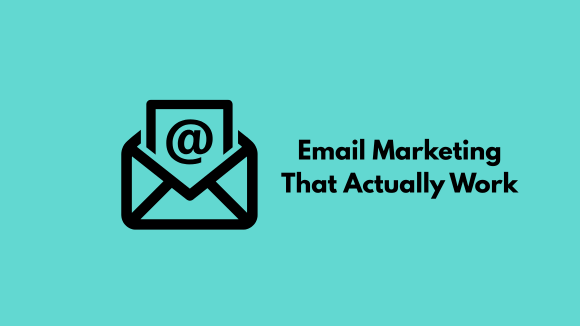10 Email Marketing Tips for Your Business That Actually Work

By Vinod Mathew Sebastian on October 2, 2025
Email marketing is a powerful tool in the world of digital marketing. With a staggering return of $42 for every $1 spent, it is one of the most cost-effective channels available. It's the kind of return that keeps a digital marketer glued to his inbox late into the night, tweaking the copy and looking at the analytics dashboard.
But a lot of email marketing campaigns fail because they are either based on outdated strategies or based on guesswork. In this article, I’m going to share the top 10 email marketing tips that actually work. When applied properly, these tips boost open rates and turn subscribers into paying customers. Whether you're a small businessperson sending your first newsletter or a digital marketing team scaling to many thousands, these tips will improve your email marketing campaigns.
1. Build an email list of engaged subscribers and keep it clean
If you think that it is beneficial just to have more subscribers, you are wrong. A list full of cold leads is, at best, a waste of time. What we need is a list full of engaged subscribers who open, click, and convert at rates up to 5x higher than passive ones.
Use opt-in forms with clear value propositions (e.g., "Get my free guide to email marketing"). Tools like ConvertKit or Mailchimp make lead magnets a breeze.
Regularly clean your list by segmenting out inactive subscribers. Send a re-engagement campaign every 90 days: "Missed you! Here's an exclusive offer - reply if you want more, or unsubscribe if not."
Fix bounce addresses, and make it easy for people to unsubscribe. The average email bounce rate across industries is 2.48%, according to WebFX, but keeping your list clean can help you stay well below this average.
2. Segment your email list into different categories for relevant messaging
Do you send the same email to everyone? That was 15 years ago. Your subscribers are not the same anymore. Today's inboxes crave personalization, and segmentation is your weapon. When people feel seen, they engage.
By dividing your email list, you can customize your messages for different groups according to factors such as age, buying patterns, or how engaged they are. This focused method results in better engagement and increased conversion rates. In fact, segmented email campaigns generate 36% of total email revenue, according to this report.
Establish segments such as "New Subscribers," "Returning Customers," or "Inactive Users" to provide appropriate content and promotions.
3. Send personalized emails beyond the customer’s name
While using a subscriber's first name is a good start, true personalization goes much deeper. True personalization digs into behaviors and preferences for that "they get me" vibe.
Personalized emails deliver 6x higher transaction rates compared to non-personalized emails.
Use behavioral data, purchase history, browsing activity, and preferences to create hyper-relevant email experiences.
Leverage dynamic content blocks in your ESP (Email Service Provider) that change based on user segments, product recommendations based on browsing history, location-based offers and content, and behavioral triggers (e.g., time since last purchase).
Pull in purchase history ("Loved that phone? Here's a matching case") or browsing data. A/B test levels - start with subject lines, then body copy. Privacy first: Always comply with GDPR/CAN-SPAM and offer easy opt-outs.
4. Optimize your emails for mobile devices because desktops are getting irrelevant.
Since 50-60% of all email opens now happen on mobile devices (OptInMonster, 2025), making sure your emails work well on smartphones is essential. Furthermore, 85% of users access their inboxes on mobile devices according to this 2025 report. Implement responsive design, use short and clear text, and include straightforward calls-to-action to improve the experience for users on smaller displays.
Use responsive templates (Litmus, Email on Acid, or free starters for testing). Single-column layouts, big buttons (44x44 px min), and short paragraphs. Alt text for images and preview panes that shine in 320px width.
Check how your emails appear on different devices before you send them to confirm that they look good. Test on both iOS and Android platforms.
5. Write irresistible subject lines that your subscribers can’t ignore
The first thing people see in your email is the subject line. Having a strong subject line can greatly increase the chances of how many people open your email. According to recent benchmarks, the average email open rate across industries is approximately 37.93%, with top performers achieving 54.78% (Klaviyo, 2025). Make sure your subject line is short, understandable, and interesting. Adding a personal touch, like the name or location of the person receiving the email, can also help.
If the subject line evokes curiosity and it has value, it leads to inbox domination.
Mix emotions, questions ("Ready to crush your Q1 goals?"), numbers ("5 Hacks to 2x Your Conversions"), or teasers ("This mistake costs money every month"). Use emojis sparingly - they boost opens by 10-20% but can fail in B2B.
Tools like CoSchedule's Headline Analyzer are great for this.
It is best to keep subject lines under 30-40 characters for mobile devices. For example, the iPhone email app only displays the first 30 characters.
6. Provide valuable and relevant content
Give first, and the sales follow.
Emails that give value are more likely to catch the attention of your subscribers. Offer content that is informative, give special discounts, or provide practical advice that aligns with what your audience cares about. This method helps to create trust and motivates them to interact again.
Remember, 59% of consumers say marketing emails influence their purchase decisions (HubSpot).
Use the 80/20 rule: 80% free insights, 20% promo. Share tips, stories, and resources. Series like “Monday Tips" keep them hooked. Survey for what they crave.
7. Use email automation
Automation is your 24/7 salesperson with a personal touch. It can dramatically improve your results.
Research shows that automated workflows generate 30x higher returns compared to one-off email campaigns (eMailmonday, 2025).
Set up automated sequences for welcome series (3-5 emails), abandoned cart (urgency timers), birthday or anniversary emails, post-purchase nurture campaigns, and re-engagement (win-back offers).
Infuse personality - use your brand voice, not robot-speak. Monitor for fatigue; cap at one per week unless triggered.
8. Write compelling, not confusing CTAs
Your email content might be excellent, but without a clear, compelling call to action, subscribers won't take the desired next step. The average click-through rate across industries is 2.44% (WebFX, 2025), which means your CTA needs to stand out and provide clear value.
A weak call to action is like a "Buy Now" button in invisible ink. Make it pop and propel.
Changing a "Learn More" to "Claim Your Free Audit" on a consulting firm's email leads to improved conversions.
Emails with a single, clear CTA see 371% more clicks (WordStream). Clarity cuts decision paralysis.
Use one CTA per email, above the fold. Action verbs ("Grab Your Spot," "Unlock Now") + benefits ("Save 50% Today"). Contrast colors, urgency ("Limited Time"). Track with UTM parameters.
9. Relentlessly A/B test your campaigns
Never assume you know what works best. That's gambling. Testing is science. Data doesn't lie; egos do.
A/B testing can improve performance by 20-50%. Continuous A/B testing allows you to optimize every element of your emails, from subject lines and send times to content layout and call-to-action buttons. Test one variable at a time to clearly identify what drives better performance.
Subject lines and preview text, send times and days of the week, email design and layout, call-to-action button text and placement, and image vs. text-heavy content - all these can be tested.
Start small. Use your ESP's built-in tools (Mailchimp's is newbie-friendly). Aim for 20% of the list per variant, statistical significance (p-value less than 0.05). Iterate weekly.
10. Track and analyse the right metrics and then optimize
Metrics don’t lie; they're your GPS.
Keeping an eye on important measurements like the rate of opened emails, clicks, and conversions enables you to see what is effective and what requires improvement.
But vanity metrics (opens) distract, while revenue metrics (Customer LIfetime Value - LTV, Customer Acquisition Cost - CAC) direct.
Campaigns tuned to key metrics like click-to-open rate (ideally 10-20%) and ROI evolve into profit machines.
Utilize analytics tools to collect information and adjust your email marketing approaches as needed.
Core KPIs are opens, clicks, conversions, and unsubscribe rate.
For open rates, aim for above the industry average of 37.93% (Klaviyo, 2025). For Click-Through Rate (CTR), 2.44% is the average, according to this benchmark by WebFX. For conversion rate, track sales or desired actions from email campaigns. Keep the bounce rate below the 2.48% industry average. Monitor trends and investigate sudden increases in the unsubscribe rate, and calculate revenue generated per unit of money spent with ROI.
Tools like Google Analytics and the email service provider (ESP) dashboards are helpful. Set alerts for drops and review monthly. Celebrate wins, autopsy fails.
Wrapping up
By combining these email marketing techniques with your overall digital marketing and SEO efforts, you can greatly improve your business's visibility online and how well you connect with customers. With 41% of marketers citing email as their most effective channel (eMailmonday, 2025), investing time in these strategies will pay dividends.
Building an email list of engaged subscribers, dividing your audience into groups, personalizing experiences, ensuring mobile-friendliness, attractive subject lines, offering useful content, implementing automation, crafting compelling CTAs, conducting A/B tests, and consistently analyzing your results can lead to successful email campaigns that achieve your goals.
Remember that nearly 4.5 billion people use email worldwide in 2025 (OptInMonster, 2025), making it an indispensable channel for reaching and engaging your target audience.
If you would like help applying these methods or want your email marketing campaigns to be highly successful, please don't hesitate to contact a professional digital marketing agency.
What's your biggest email marketing challenge right now? Drop a comment below. Also, for any questions, please feel free to ask!
